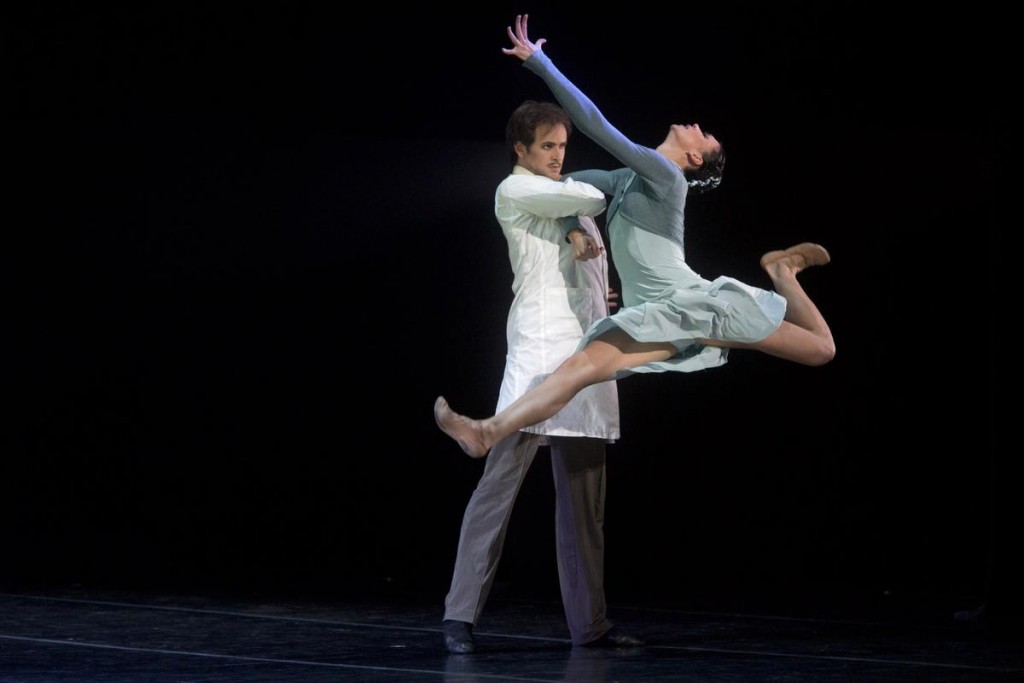
Oleg Gabyshev and Lyubov Andreyeva in the west coast premiere of “Up and Down” at the Segerstrom Center for the Arts Friday night. Photo: Drew A. Kelley
Billed as “the culmination of the artistic director’s cycle of ballets on psychiatric themes,” Eifman Ballet of St. Petersburg premiered “Up and Down” (2015) on the west coast on Friday. A cobbled story of love and madness set in the frenetic gaiety of the 1920s jazz-age, the off-key work earned tepid response from heretofore unshakeable fans at Costa Mesa’s Segerstrom Center.
The two preceding works, also doomed romances, both drew healthy houses to Segerstrom – Eifman’s loose adaptation of “Anna Karenina” (2005) and a telling of the Auguste Rodin-Camille Claudel relationship in “Rodin” (2011), which the company brings to the Dorothy Chandler Pavilion this week.
Yet though the cycle may be finished, no sign that Eifman’s own torturous pendulum swings – a genuine movement freedom paired sourly with musical nostalgia and cockeyed thematic choices – is over.
Structural integrity and meaning suffer miserably in “Up and Down.” Originally modeled on “Tender is the Night,” F. Scott Fitzgerald’s uneasy novel about the marriage between psychoanalyst Dick Driver, who falls in love with his patient, Nicole, “Up and Down” also attempts to offer a celebration of George Gershwin, with a dozen of his popular standards performed and recorded for this ballet by the Slovak Radio Symphonic Orchestra and Milo Suchomel Orchestra.
Ill collusions abound. Jazz-age signifiers are smeared across Act I’s mental-ward setting, casting the patients as madcap loonies bouncing to Gershwin syncopations. Zinovy Margolin’s hospital set, a frosted-glass backdrop with doorways, reads like a low-end nightclub, and Olga Shaishmelashvili’s exaggerated costumes evoke gory ragamuffins in a doll hospital. (On the count of 8, one man repeatedly yanks suicidally on the noose suspended from his neck, while another wrestles with his outsized suspenders, making his pants dance.)
During alternating scenes in a “real” nightclub (the backdrop now emblazoned with geometric neons and a garish purple light flooding the stage), sets of couples deliver very orderly, non-specific social dances – including one inscrutable scene of “basketball” – which convey neither wildness nor heat nor any true modern rhythm.
Society is not Eifman’s strong suit; romantic struggle is his essential lure, and the palatable moments here are the duets and trios. As in the Fitzgerald novel, the story follows a psychiatric patient (Lyubov Andreyeva) and her doctor (Oleg Gabyshev), who uncovers the childhood incest behind her neuroses and then becomes her lover. The plot veers somewhat, but dangling pieces from Fitzgerald pop up in Act II in the character of the movie star (Maria Abashova) and Buddy (Dmitry Fisher).
The conveyance of madness is built into classical ballet, but it’s harder in Eifman’s movement world. Though he employs classically trained dancers who carry themselves with glorious comportment, he springs them from the classical form to build new vocabulary from their limbs. Unlike “Swan Lake” or “Giselle,” where the intensifying repetition of classical steps can indicate madness and sacrifice and suffocation, Eifman’s phrases are full-bodied, unique and free.
In duets, the limbs and energies of both partners come together – often in silhouette – in new shapes that feel immediately clean and legible, making for a kind of elegant sans serif calligraphy. Two outstretched bodies, featuring a combination of ascending and descending lines, often feel like extensions that flow from a single stroke.
Yet Eifman’s understanding of design integrity in human forms feels to appear nowhere else. He chops up music, showing no faithfulness to a score. He alternates pieces from Chopin and Gershwin as if they were stage makeup, to add color and outline existing features. He wants to tell stories but he does not properly establish setting, either with sets or music. To convey ‘madness’ within such a free movement idiom, he moves into cliched or downright ridiculous territory: characters bear in-toed Nijinksky poses or rattle the ‘marbles’ in their heads (complete with cross-eyed expressions) or crudely mimic acts of metered self-destruction. Interestingly, however, is that lead dancer Gabyshev’s descent into full madness culminates with virtuosic jumps and turns. Loss of stylistic integrity here means a descent into the formal tradition.
As if recognizing the ballet’s storytelling weakness, Eifman fuels “Up and Down” with added character treachery. Wisely, at first, Eifman resurrects the dead father from Fitzgerald’s story (Jiří Jelínek) so as to choreograph a series of duets and trios that allow viewers to see the legacy of shame pass from parent to child. Yet he also has the father assume the role of financier (Fitzgerald’s couple was subsidized by a sister), a final operatic and distancing misstep for Act II.
[A version of this review originally ran in the Orange County Register.]